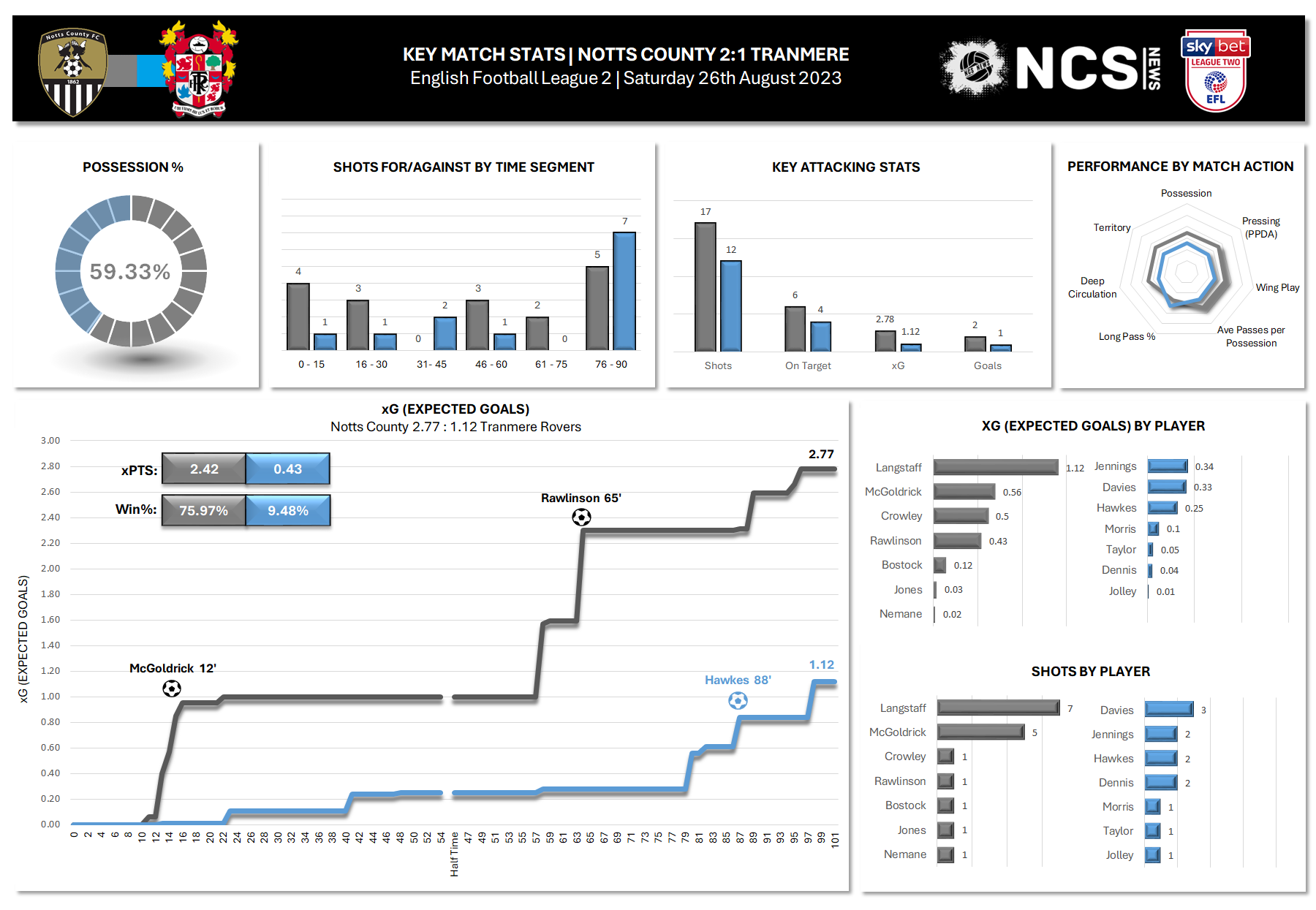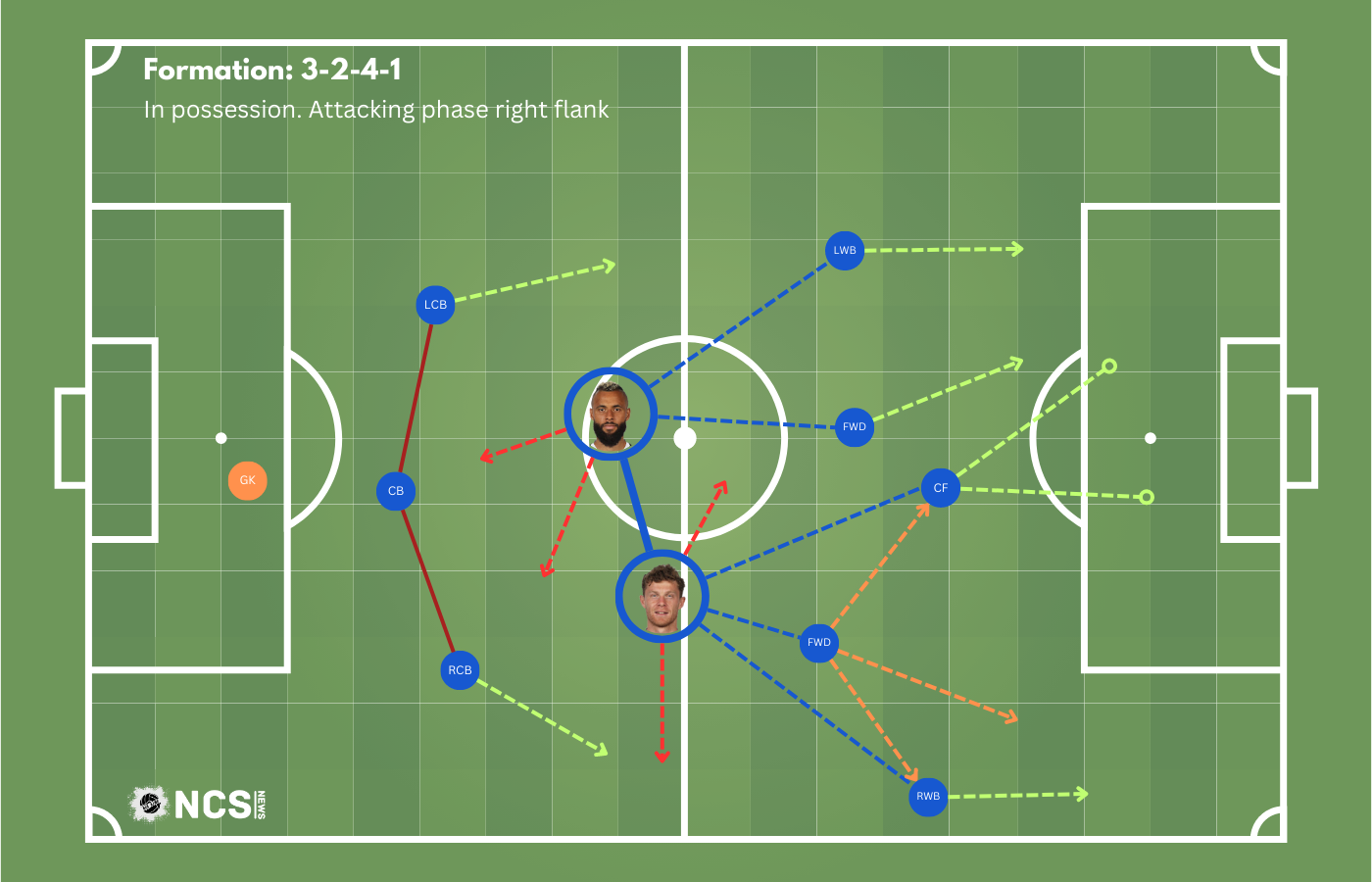For approximately 80 minutes we were treated to the kind of display from Notts we became more accustomed to seeing last season. Luke Williams' men were nothing short of dominant and on another day could have had a hatful with Macaulay Langstaff, Dan Crowley and David McGoldrick all missing big chances. However, it was the latter who set the Magpies on their way with a goal that showcased his quality and calmness.
The second finally came via an unexpected source in Connell Rawlinson. A well worked short corner saw a Dan Crowley dummy pass send no fewer than 3 defenders the wrong way, opening up space for Matty Palmer who somehow managed to find Rawlinson, the only Notts player in the six yard box and surrounded by 5 Tranmere defenders.
Shortly after the second goal Williams made a raft of changes in 10 minutes meaning there would be a period needed for the substitutes to settle in to what had been a high tempo performance to that point. Unfortunately, with the full compliment of available substitutes on the field of play Notts found themselves down to 10 men as an injured Cedwin Scott limped off after just 13 minutes on the pitch. In true Notts style it made for a nervy ending as Tranmere managed to pull a goal back and continue to apply pressure, looking for the equaliser. Thankfully Notts held firm and secured a third win in 4 games which sees them 4th in the league just 2 points behind the leaders.
In our NCS Shorts podcast on Thursday I suggested Tranmere would offer stern resistance and predicted a 2-2 draw, however, had they managed to grab that equaliser in the latter stages it would have been nothing short of daylight robbery. This is clearly apparent in the xG analysis which suggests an expected points of 2.42 and an expected win percentage of 75.97% with the three missed chances mentioned earlier influential in those numbers.
Tranmere certainly had their moments and at times proved to be very comfortable on the ball despite a lack of threat for most of the game. At 59.33% possession Tranmere saw more of the ball than any of Notts' opponents so far this season, but much of that can be attributed to the final 20 minutes including added time where Notts were down to 10 men.
Macaulay Langstaff had the most shots accounting for 7 of the 17 attempts on goal by the Magpies with an xG of 1.12 in total.

One of the standout performances of the game came from John Bostock who quite possibly had his best game in a Notts county shirt and its interesting to see how his relationship with Matty Palmer is really starting flourish.
Luke Williams utilises both Bostock and Palmer as a 'Double Pivot', a role that is really starting to develop and one that ultimately has the potential to become the best midfield pairing in League Two.
A double pivot is normally used in a 4-2-3-1 formation with the two central midfielders being slightly more defensive whilst providing an outlet to the attacking players, in particular a traditional #10. However, under Williams the pivot is used in a 3-4-2-1 system, albeit not a traditional take on the tactic, has a fluidity about it that provides rewards in the attacking phases but also greater control in the middle.
Both players have to be extremely disciplined in their roles as they provide cover in the defensive transitions and overloads in the attacking phases. Additionally they are tasked with being disrupters in the centre of the park, picking up loose balls and recovering possession. On Saturday what we saw was Bostock very much playing the role of the disruptive midfielder, breaking up play and successfully winning his duels to recover the ball for Notts. This allowed Palmer to play higher up the field when back in possession resulting in creating the extra player in the final third.
To add some context Bostock was 88% successful in all of his match actions combined, winning 67% of his duels and completing 94% of his passes. It was because of this that Palmer was able to push higher, especially in the first half where he linked up nicely with with the three right sided players Rawlinson, Crowley and Nemane whilst also being conscious of his defensive duties when the play was switched to the left. Bostock would migrate towards Cameron, Jones and McGoldrick, confident in the knowledge that his partner in crime would be providing the cover in behind.
The tactical board below shows how both players are linked in the centre of the park but also how it allows them to create the overloads in the attacking phases whilst maintaining the cover in behind the attacking line, something that also allows the wide centre backs to also play much higher in the attacking transitions.

Whilst deploying the double pivot has its rewards it does have it's disadvantages. A traditional double pivot means the midfield pairing sit deeper just in front of a back four and therefore the full backs are the players needed to provide the extra man in the attacking phases. However, in Luke Williams' system one of the pairing is naturally involved in the attack when in position, and with the centre backs also employed in a much higher line ball losses in the final third can result in being exposed to the counter attack. I'm pretty sure there isn't a single one of you reading this that hasn't witnessed this when watching Notts under Williams.
However, it's a risk that is far outweighed by the rewards and whilst the execution this slightly unorthodox version of the double pivot requires a high level of discipline, skill and vision we have a pairing in Bostock and Palmer who will only get better as the system continues to develop.